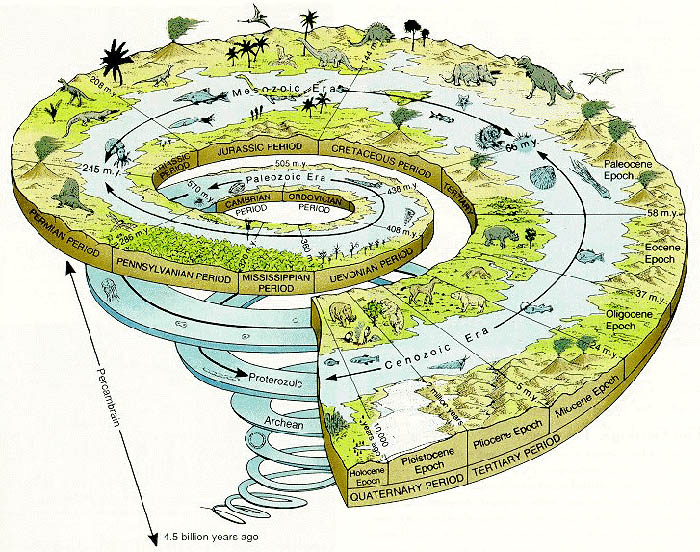The Timeline of the Time Scale
The history of man demonstrates the beauty of learning from the past. Geologists are no exception. From our first observations of Earth to our current investigations into the intricacies of radiometric dating, we have been making use of the intellect of our past teachers to extend the knowledge of the next generation of students. Directly or indirectly we are pupils of past intellectuals. Their teachings allow us to make new intellectual leaps leading to even greater gains by future generations.
 For awhile, Europeans left the growth of science to others. Aristotle’s works represented the extent of Europe’s scientific endeavors until the 1400’s. Arabs carried on the Greek ideas while Christian Europe’s intellectual development stagnated. The lack of an empirical view of Earth led to an atrophied scientific mindset in Europe. St Augustine (354 – 430) had written that Genesis exaggerated the simplicity of creation, though; so Genesis, in his view, could not be taken literally. He argued that the story of creation was generally correct although the specifics of time were suspect or metaphorical. In the 15th century, new explorations triggered a renewed interest in Earth. With the literal broadening of Europeans’ horizons, many long-held ideas deteriorated under the weight of new evidence. Da Vinci’s (1452 – 1519) ideas were in contrast with the views of the church. The church interpreted Genesis literally in da Vinci’s time. On the other hand, da Vinci wrote of fossils and their formation. He talked of a process by which animals died and were covered, and stones formed around them. Presumably, geologists find the fossils in this final stage. All together, da Vinci’s intrinsically long process fell outside the bounds of seven days of creation. His idea implied an age of Earth the church could not accept. From the time of Augustine to da Vinci, European scientific thought no longer stood on the shoulders of giants and moved forward, but sat down and took a thousand-year reprieve. Da Vinci and European explorers reenergized the scientific minds out of their doldrums. They learned from each other and climbed…
For awhile, Europeans left the growth of science to others. Aristotle’s works represented the extent of Europe’s scientific endeavors until the 1400’s. Arabs carried on the Greek ideas while Christian Europe’s intellectual development stagnated. The lack of an empirical view of Earth led to an atrophied scientific mindset in Europe. St Augustine (354 – 430) had written that Genesis exaggerated the simplicity of creation, though; so Genesis, in his view, could not be taken literally. He argued that the story of creation was generally correct although the specifics of time were suspect or metaphorical. In the 15th century, new explorations triggered a renewed interest in Earth. With the literal broadening of Europeans’ horizons, many long-held ideas deteriorated under the weight of new evidence. Da Vinci’s (1452 – 1519) ideas were in contrast with the views of the church. The church interpreted Genesis literally in da Vinci’s time. On the other hand, da Vinci wrote of fossils and their formation. He talked of a process by which animals died and were covered, and stones formed around them. Presumably, geologists find the fossils in this final stage. All together, da Vinci’s intrinsically long process fell outside the bounds of seven days of creation. His idea implied an age of Earth the church could not accept. From the time of Augustine to da Vinci, European scientific thought no longer stood on the shoulders of giants and moved forward, but sat down and took a thousand-year reprieve. Da Vinci and European explorers reenergized the scientific minds out of their doldrums. They learned from each other and climbed…
The reasons for the names of the time scale
Naming of the individual sections of the timescale has been dominated by British Geologists; including William Smith, the ‘father of English stratigraphy’. Stratigraphy studies the rock sequences therefore leading to a chronology of deposition. The geologic time scale consists of labels for rock layers. The rocks are grouped together based on age, while the origin of the names generally arises from an area with a distinct example of rock from that time period, predominantly named by British geologists. Now, the International Commission on Stratigraphy is charged to make the nomenclature consistent. The geologic time scale employs absolute dates as in the field of geochronology.

